Spanish gardens are built as a respite from the warm Mediterranean summers, characterised by intimate courtyards, airy patios, and refreshing pools. They’re sanctuaries from the arid climate of the region.
However, these gardens aren’t just places to grow pretty plants; they’re made for lounging, enjoying weekend lunches with friends and family, and catching up during sobremesa (after-meal socials).
So, how can you create the Spanish garden experience in your own home? There are several design elements, details and, of course, native Spanish flora that make up the quintessential Spanish garden. Here, we take a look at 16 Spanish themed garden ideas to help you bring a touch of the Iberian peninsula to your backyard.
Using Spanish Themed Garden Ideas to Plan Your Layout
Spanish home and garden designs are heavily influenced by early Roman and Moorish architecture. You’ll often find columns, arches, and loggias, and layouts inspired by the “paradise gardens” of ancient Persia. These gardens are often symmetrical, and arranged around a central pool or fountain – take a look at our article on Moroccan themed garden ideas for more inspiration.
With a design history rooted in so many rich cultures, Spanish gardens can include any combination of planted areas, patios, courtyards, water fountains, vibrant colours and ornate tiling.
Staying cool in a walled courtyard
To help survive the heat of the Mediterranean climate, Spanish gardens are designed to be used like an extended, open living room, where residents can entertain guests and relax even in the midday sun. In some homes, the garden will be an inner courtyard that’s partly – or completely – surrounded by the walls of internal rooms. However, you’ll typically find that even “conventional” gardens are enclosed by walls, rather than fences.
You might not have a lot of choice about how your home and garden physically intersect, but there are ways to incorporate these elements of privacy and intimacy regardless of whether you have an inner courtyard.
The best-case scenario is if your indoor living area already opens out onto your patio, making both spaces feel bigger. If this isn’t the case, aim for your outdoor seating area to be as comfortable and sheltered as your living room, and replace any low fences or slatted fences with something more solid. Walls would be great, but even a taller, more solid fence will work.
Create satisfying symmetry
As we mentioned, Spanish garden layouts are largely inspired by ancient “paradise gardens”. These were usually rectangular, with long paths, geometrically-shaped beds, and topiary plants in symmetrical formations. Pools and channels of water (rills) would often be used to divide the garden into sections, with each area having a different focus (e.g. a patio space, flower beds, a fountain etc.)
Dividing a garden into several “mini gardens” is a timeless design strategy, and a great way to get more out of the space (and make your garden seem bigger)! If you like the idea, know that you don’t have to use water features to define the boundaries – paved pathways or low walls evoke the Spanish style too – and are much easier to maintain.
Stucco, brick and tiles
Traditional Spanish garden walls are usually built with brick, stone, and white stucco. The reason being that brick and stone were easier to find in arid regions, while the white helped deflect the sun’s rays rather than absorb its heat.
Colourful and ornately decorated tiles (called Azulejos) are used in most outdoor areas to stand out against the white walls. They appear in fountains, pathways, staircases, wall sections and doorways. Meanwhile, red clay tiles – often called Saltillo tiles – are commonly used for flooring and roofing.
Crisp white and burnt red is an iconic colour combination when it comes to Spanish architecture. Even if you don’t fancy retiling your roof and covering your home in stucco, try to find ways to incorporate the colours into your patio, planters and edging.
Spanish Themed Garden Ideas: Outdoor Structures
There are a few simple signature elements that make Spanish gardens comfortable, inviting and elegant. When you’re trying to find Spanish themed garden ideas for your space, these are the go-to features that will make all the difference.
Arches and columns
Some of the most impressive features you’ll find in Spanish gardens are arched doorways and loggias – open corridors that face the garden (similar to cloisters). Derived from Roman architecture, loggias are a beautiful way to connect the interior of a building with the outdoor entertaining space.
Adding arches and columns to your home can be a significant investment, and might not always work visually with the rest of your property (or neighbouring buildings). However, there are ways you can create similar effects with awnings, posts, decking and even creative painting.

photo by Daria Nepriakhina
Terraces
Similar to Moroccan garden design, Spanish gardens are intended to be viewed from above (for example, from the upper rooms of the house). Terraces are common focal points in Spanish-style houses, helping to make sense of the garden as you view it from indoors. Spanish terraces are often decked out with furniture, pots, and small house plants. If your house doesn’t have a large terrace, you can also spruce up any garden-facing balcony with creeping vines.
Pergolas
If you’ve read any of our other posts, you’ll know by now that I’m a huge fan of pergolas. If you’re not familiar, pergolas are a tall garden structure made from wooden cross beams supported by posts along the edge – think “gazebo”, but with an open roof. We covered even more garden shelters so check that out.
The design provides some shelter from the weather, but is also a great support for climbing plants and flowers. In Mediterranean countries, you might find pergolas covered with wisteria, or grapevines.
Building a pergola gives you a focal point that’s beautiful and practical – and very evocative of Spanish garden design.
Reflecting pools and water features
We’ve already touched on the ways in which water can feature in Spanish themed garden ideas. Reflecting pools and fountains are a major feature in both Roman and Persian gardens, and have thus been adapted into Spanish ones as well.
In the Mediterranean heat, water features help make gardens a refreshing place to hang out and cool down. The reflective surface of a pool also adds a sense of tranquility to a garden – mirroring the trees, plants, and sky on the water.
Of course, installing a fountain can be a considerable commitment (we’ve got some tips on doing so in this post), but you don’t have to exactly replicate the scale of pools in historic Mediterranean gardens. Depending on the space you have, you might prefer anything from a small fish pond to a water rill leading to a tiered fountain. Really, the average Spanish courtyards might only feature a small tiered water fountain in the centre, or a spout pouring from a wall.
Intricate ironwork
While stone, brick, and stucco are the main materials used in Spanish-themed gardens, you’ll find ironwork in small doses too. One of the most common ways of incorporating iron into your garden design is with wrought-iron balcony railings – depending on your taste, you can choose straight bars or designs that twist and swirl.
Aside from balconies, you can incorporate iron into Moorish-style wall-mounted lanterns, garden chairs, and light fixtures.
Bright blue details
An unexpected design feature in many mediterranean gardens is the use of bright blue paint – specifically, Majorelle Blue. The colour was made famous by French Orientalist Jacques Majorelle, who incorporated the intense blue in his life’s work – a two and a half acre botanical garden in Morocco.
If you’re going for a more Moroccan/North African-influenced Spanish garden, one easy way to do so is to paint certain design elements blue. Doors, pots, even fountains – these can all be painted blue to give your garden a touch of the Morocco feel.
Mosaic elements
Mosaic tiles are traditionally used to add colour and break up an otherwise monochromatic palette – similar to the patterned tiles we mentioned earlier. Mosaics are often seen in flooring, tabletops and flower pots, but can be incorporated into pretty much any garden feature.
If do you take the plunge to paint your garden bright white like they do in Spain, careful use of mosaic elements can prevent it from looking too plain!
Landscaping with Native Spanish Flora
Of course, no garden is complete without some plants. Spanish gardens tend to focus on drought-tolerant landscaping, with hardy trees, flowers and succulents that can handle the scorching heat and icy frosts of the Iberian climate. These plants make a surprisingly practical choice for gardens in the UK; our cool, moist weather is when many succulents grow at their best, and even our cold winters aren’t harsh enough to kill them off.
Here are some of the most common plants and blossoms you can get in a Spanish style garden.
Citrus trees
Citrus trees are a common sight in Spain, and can even be found lining the sidewalks of Valencia! With that in mind, anyone gunning for an authentic Spanish garden should absolutely consider planting a small citrus orchard. They look good, they smell good, and they provide tasty fruit. Full disclaimer – if you want them to actually fruit, you’ll need to grow your citrus trees in pots and protect them from the cold!
Cypresses
Cypress trees play a central role in the Persian paradise garden, so it would only make sense for you to get some for your Spanish-inspired landscape. Depending on which type of tree you get, Cypresses can grow tall and slender, making for great path liners.

Cacti and succulents
In the arid Spanish climate, only a handful of plants can survive the harshest summers. To avoid wasting water, the obvious choice is to invest in plants that can be maintained with minimal watering.
Creeping vines
Another way to break up plain white walls is to grow vines and climbing plants up and across trellises and twine. Vines are perfect for pergolas, too.

Hibiscus
When you’re looking for landscaping ideas, don’t forget the flowers. Just like citrus trees, hibiscus flowers are a staple of Spanish garden design. You’ll see them growing along roads, around shopping districts and in courtyards – both as large hedges and potted plants.
When drumming up landscaping ideas, don’t forget to decorate your walls too. One way you can make use of hibiscus is by hanging dozens of pots all over your courtyard walls.
Lavender
Lavender fields are often associated with rural England and France… but you can also get Spanish lavender, which can tolerate the Mediterranean heat much better!
Relaxing in Your Spanish Garden
Once you understand the roots and history of Spanish garden design, recreating your own Iberian-inspired garden will be seamless. Recognising how to incorporate some of the stunning features from Roman and Moorish design will help you hone your Spanish themed garden ideas into a beautiful space that’s unique to your home.
With a little curation, you can create your own sunny sanctuary away from the chaos of everyday life, and welcome your friends to join you there. After all, Spanish style gardens are intended to be the perfect place to gather, relax, and enjoy the simpler things in life.

Save this pin for later





















